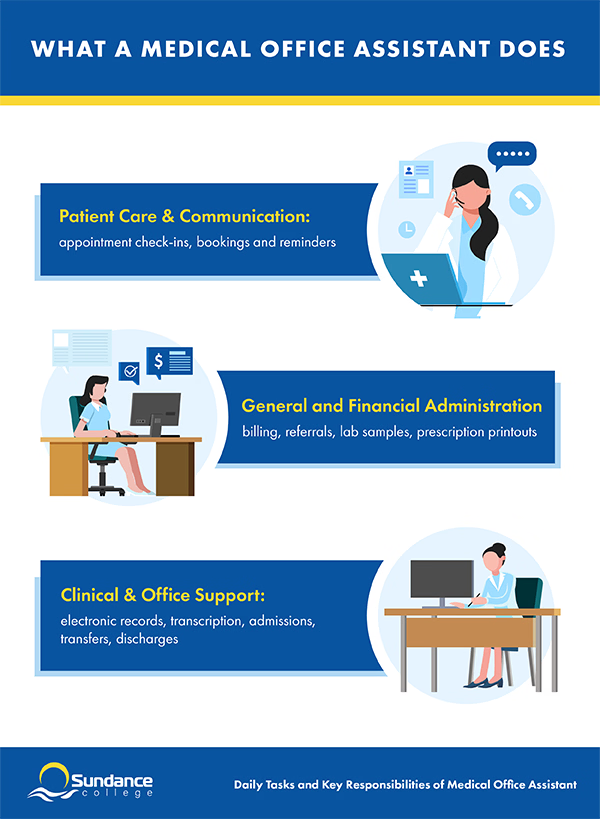Blog / Daily Tasks and Key Responsibilities of Medical Office Assistant
Daily Tasks and Key Responsibilities of Medical Office Assistant

Medical Office Administration – Health Unit Coordinator Diploma
- Medical Receptionist
- Medical Secretary
- Medical Office Assistant
- Hospital Unit Clerk
Table of Contents
You’ve probably met a medical office assistant at your local clinic before.
Whether you needed to check in for an appointment, confirm paperwork, or pick up a test requisition, the credit for making the entire process easier goes to them. Now picture yourself in that role, welcoming patients, preparing records, and being part of the team that delivers essential care.
So what would you do each day as a medical office assistant? How do you become an MOA, and what opportunities can this career open? Let’s find out.
Listen to: Daily Tasks and Key Responsibilities of Medical Office Assistant
Core Responsibilities: What Does a Medical Office Assistant Actually Do?
As a medical office assistant, you’ll serve as the link between patients, medical staff, and office operations.
Whether you’re in a private clinic, a dental or optometry office, a community health centre, or even a long-term care home, your day may shift from supporting patient care to managing records and coordinating tests, referrals, and follow-ups with healthcare providers.
This variety highlights how broad MOA duties can be across different settings.
Patient Care and Communication

You’ll handle patient communication at every stage of their visit. Before appointments, you may connect by phone or email to confirm schedules, answer questions, or provide instructions.
When patients arrive, you welcome them, help with forms, confirm the reason for their visit, and update records for the medical team. After the appointment, your role may continue with follow-ups such as sending reminders, sharing paperwork, or coordinating referrals.
These clinical interactions create a welcoming experience for patients and give medical staff the details they need to provide effective care.
Administrative & Financial Duties
In addition to patient care, you’ll take on various clinic administration and financial duties.
Your role will include medical office billing for patients and insurance providers, updating correspondence such as exam notices or referral forms, and coordinating with specialists for referrals. You’ll also send lab samples for analysis, record and compile patient information, and print prescriptions when needed.
By managing MOA administrative duties effectively and keeping the clinic organized, you make it possible for medical staff to give patients their full attention.
Clinical and Office Management Support
You’ll also play a key role in clinical and office management. Each day, you’ll be updating electronic health records, pulling together paperwork for diagnostic tests, or typing out a physician’s notes so they are easy to reference. In hospitals, you may also work as a unit clerk, handling order entry as well as patient admissions, transfers, and discharges.
What does this mean in practice? Healthcare providers like doctors and dentists are free to focus on treatment, departments work together without barriers, and patients receive timely and attentive care. Your role helps create an environment where medical teams can excel and patients can thrive.

Where Can a Medical Office Assistant Work?
Medical office assistants are needed across many parts of the healthcare system, with salaries reaching up to $50,980 annually.
Typical MOA work settings include doctors’ offices, medical clinics, hospitals and private practices such as dental, optometry, chiropractic, and physiotherapy offices.
They are also employed in outpatient care centres, and insurance companies. MOA jobs can extend further to public health settings, including government health agencies and community health centres, as well as nursing homes and long-term care facilities.
These diverse workplaces give you the flexibility to build a career in a setting that aligns with your skills and interest.
How Do You Become a Medical Office Assistant?
To become a medical office assistant, you need MOA training that builds practical administrative skills and knowledge of healthcare practices. Employers want graduates who are trained in electronic health records management, medical terminology, medical office procedures, and how to communicate effectively with patients and healthcare teams.
Educational Requirements and Training Programs
At Sundance College, the Medical Office Administration – Health Unit Coordinator diploma program will equip you with both the administrative and clinical skills needed in today’s healthcare settings. You’ll learn medical terminology, anatomy, transcription, electronic health records, billing, diagnostic testing, and pharmacology basics, while also developing professional communication skills.
Online learning is paired with a practicum in a healthcare setting such as a clinic, community health centre, or other medical facility. This gives you the chance to apply what you’ve learned in a workplace and develop that sought-after experience employers want.
That’s exactly what Kimberly C., a graduate of Sundance College’s Medical Office Administration program, experienced:
During my practicum, I worked in the electronic medical records (EMR) system and created spreadsheets. Because of my program, I already had a strong understanding of electronic medical records, which helped me fit right in.
By training hands-on in the essential areas you’ll face daily as a medical office administrator, you won’t just be ready to enter a new role – you’ll be ready to excel in it from day one.
To get started with your MOA training program, contact an admissions advisor today.
MOA vs. Other Healthcare Office Roles: How Does This Role Compare?
When you explore career paths connected to medical office assistants, you’ll see that some duties overlap, yet each role has its own focus.
- MOA vs Medical Receptionist
Medical receptionists work at the front desk of clinics, hospitals, and doctors’ offices, where they focus on welcoming patients, scheduling appointments, and handling calls. MOA responsibilities extend into managing records, billing, and clinical support. - MOA vs Medical Secretary
Medical secretaries prepare documents, maintain files, and assist physicians with correspondence. MOAs do this as well and also manage patient intake, electronic records, and billing, giving them a broader role across healthcare settings. - MOA vs Hospital Unit Clerk
Unit clerks work within hospitals, handling admissions, transfers, discharges, and order entry. MOAs train in these procedures and can also work in clinics, community centres, and other healthcare settings. - MOA vs Medical Billing Clerk
Medical billing clerks focus on claims, invoices, and payments. MOAs include billing in their role, alongside broader administrative and clinical responsibilities.
Because of their broad responsibilities, MOAs can adapt to a range of workplaces and responsibilities, making the role one of the most versatile entry points into healthcare administration.
Frequently Asked Questions
-
Is a medical office assistant the same as a medical receptionist?
Not exactly. Medical receptionists focus on front-desk duties like greeting patients and scheduling. As an MOA, you’ll do this and much more, including records management, billing, and clinical support.
-
Can I work in a hospital as a medical office assistant?
Yes. MOAs can work in hospitals, typically in roles such as unit clerk or administrative support.
-
How can I become a medical office assistant in less than a year?
By completing Sundance College’s Medical Office Administration – Health Unit Coordinator diploma. Training takes about 43 weeks and includes both online learning and a 5-week practicum placement in a real healthcare setting.
-
Where do medical office assistants typically work?
MOAs are employed in doctors’ offices, medical clinics, hospitals, and private practices such as dental, optometry, chiropractic, and physiotherapy offices. They are also employed in outpatient care centres, and insurance companies. MOA jobs can extend further to public health settings, including government health agencies and community health centres, as well as nursing homes and long-term care facilities.
-
Do medical office assistants interact directly with patients?
Often, yes. In clinics and private practices, MOAs regularly communicate with patients by phone, email, and in person. In hospital units, MOAs may focus more on administrative and record-keeping duties, with less direct patient interaction.
-
Is there a demand for MOAs in Canada right now?
Yes. Healthcare settings across Canada need MOAs, making it a stable and in-demand career choice.
Related Blogs
Subscribe for more career advice
Blog Categories
Share on:
